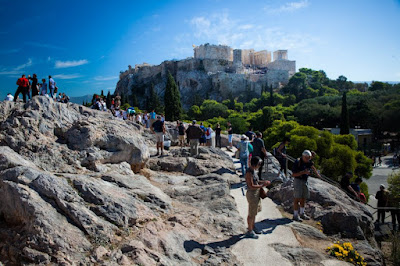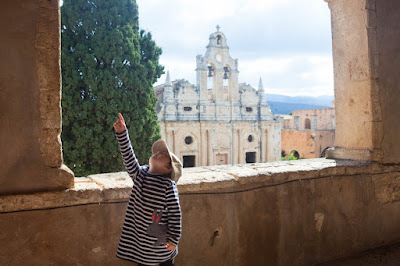Athens is a city you easily fall in love with, although perhaps not for the reasons one might think. Antiquity is here. It’s all around us, as each metro station has an embedded shrine to some ancient site. Yet the real Athens is a wonderful mixture of ancient and modern, the best parts of it remain a secret to the millions of tourists who flock to and from the acropolis on a cruise-ship bus.
They don’t see my Athens.The Acropolis is always there, but I have a tendency to forget this. As I go about life in the city I am often surprised to look up and see it.
Every corner of this city has its own story and feel.
Every Sunday morning, the little taverna at the foot of my street sets up an enormous charcoal grill with a double spit on it. On one side, hunks of fat pork roast over the coals while, on the other, fresh lamb drips away. The smell is intoxicating. It fills the neighbourhood. In my best Greek, I communicate to the owner, who speaks no English, that I have no idea what it is or what I want from it, but I know that I want to eat it. Then there are the gyros, always cheap and readily available. The husband and wife team who run the gyros place near the Canadian Institute know who I am now. They grin when I come in and ask ti kaneis (how’s it going?). They ask me something in Greek and, though I don’t understand it all, I catch the words tria koritsia (three daughters). They are asking how my girls are.
In fact, I have three young daughters who, of course, are also in Greece with my wife and me. Being a grad student with a family has its difficulties, but in Greece it’s easy. It’s a world built for families, where little old folks stop our kids on the street to kiss their heads and pinch their cheeks, almost always fumbling around in their bag for a candy. Market day in our neighbourhood means that the one side of the boulevard shuts down, and stalls and tents go up. The markets offer the freshest, seasonal produce you’ve ever tasted as well as honey, olives, wine, olive oil, and even some clothing. It seems that childhood is a lingua franca, as vendors wave at my kids, offering them things to taste and colourful fresh flowers. They get so much free candy and chocolate that I’m concerned we may need to find a Greek dentist before our time here is done.
The highlight of the kids’ time here has undoubtedly been the water. The girls love the beach, and since September and October are still warm, we were able to do two quick trips to Syros and to Crete, both of which involved lots of beach time.As a historian, the biggest shock for me has been the numerous layers of history in Greece that I’ve never considered. Of course, in my research I think a lot about Hellenistic and Roman Greece. Yet at every turn lies an ancient Mycenaean or Minoan site, reminding me that the history of this majestic land stretches far beyond the limits of my own discipline.The more recent history also looms large in the Greek imagination. On a trip to Crete, my family rented a house next to the village priest. He quickly invited us over for some of his homemade raki, while our kids played together in the driveway. He spoke almost no English, but was jolly and kind, and he doubled over laughing as he tried to correct my Athenian pronunciation to match the rough Cretan dialect. His church was turning 1000 years old that weekend, he told us, and invited us to come to visit it. When we did, he showed us the bullet holes in the building, left over from the Cretan resistance against the Ottomans and with his empty hands simulated a knife carving the eyes out of the damaged image of Jesus. Later, we visited the Arkadi monastery and saw the place where Cretan rebels and their families made their last stand against the Ottomans.
My own research has come alive in Greece. No longer limited to a database on my computer screen, the inscriptions with which I work are mostly held in museums in Athens and Delos. Being an epigrapher, I tend to gravitate towards texts at the bottom of statues and risk overlooking the rest (if it’s there). The ability to work with material culture as well as exposure to archaeologists has quickly changed this as I’ve found myself focusing more holistically on the evidence.
One rather striking piece from my thesis is a sculpture from the elegant house of the Syro-Phoenician sailors, guarantors, and merchants on Delos. They came from Beirut, and named their group after Poseidon, the “Poseidoniasts.” This immigrant group becomes visible in our sources in the second century BCE on the island, their success no doubt arising from their ability to navigate trade with the Romans. One of the group’s statues is in the National Archaeological Museum, a striking piece carved from Parian marble that portrays a nude Aphrodite. The horned Pan stands beside her, one arm on her wrist and another behind her back. Perhaps she is being accosted in the bath, as one of her hands holds a sandal to fend off the wild Pan as Eros comes to her aid. The statue is currently in a temporary exhibition on Odysseus, where it was even more striking, set against a dark background as the sounds of waves splashing and the creaking of ships’ rigging played.
The reality of research in Greece is that sources are readily available and, for the most part, easily accessible. Also, the community of academics here is first rate; every night there is a new lecture offered at one of the foreign schools. My own offerings to the academic community have been a paper about Syrian immigrants on Hellenistic Delos, given at the German Archaeological Institute, and I will give a lecture at the Canadian Institute in the spring. Otherwise, I’m hoping to finish my thesis this year, and I have a journal article and a book chapter to prepare for publication this month. There’s a lot to be done, but surrounded by my family and a community of like-minded scholars I’m encouraged to press on, my research fueled by fresh food and a Mediterranean sun that, even in winter, creates a daytime climate that can rival that of late summer in my home of Northern Ontario.
Chris Cornthwaite
Neda and Franz Leipen Fellow, CIG








No comments:
Post a Comment